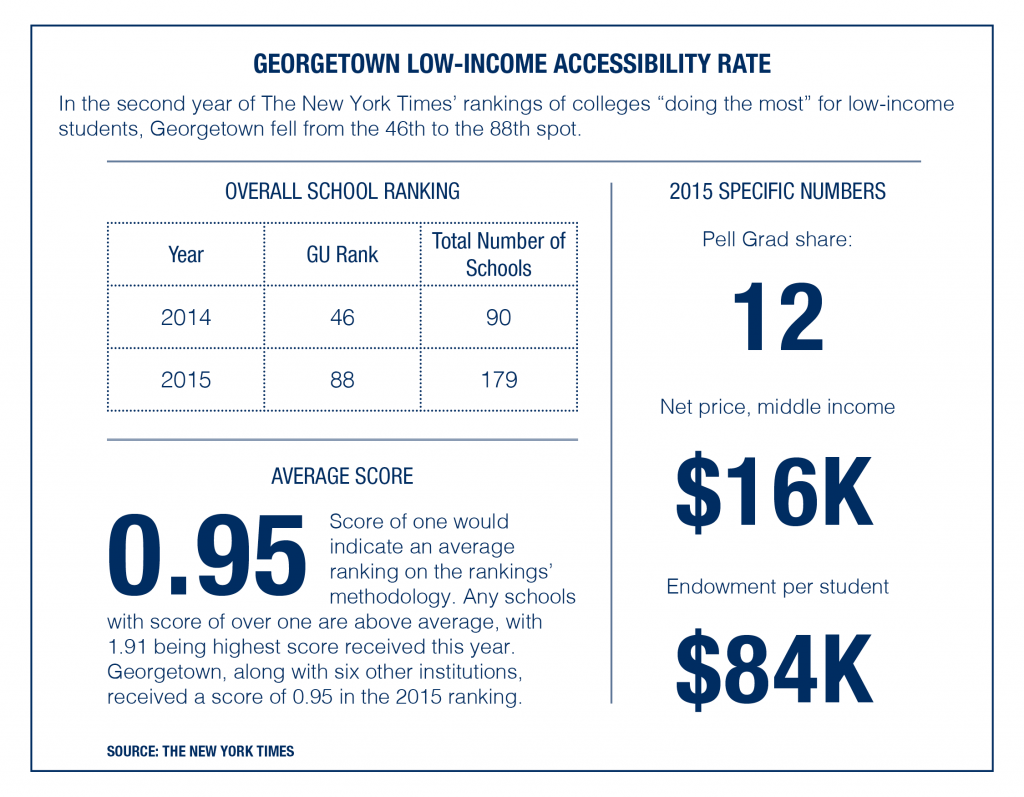Georgetown dropped in The New York Times’ rankings of colleges doing the most for low-income students, falling from 46th to 88th among the 179 schools on the list, released Sept. 16.
Launched in 2014 by The Upshot, the newspaper’s politics, policy and economic analysis section, the rankings are based on the number of students who receive federal Pell Grants, the graduation rates of those students and the average tuition cost for low- and middle-income students. Pell Grants typically go to families making less than $70,000 a year.
For Georgetown, the rankings reveal the Pell Grant share is 12, the net price for middle-income students is $16K and there is an $84K endowment per student rate.
In the second year of the rankings, The Upshot included colleges with a five-year graduation rate of 75 percent or higher, whereas the cutoff last year only applied to the four-year graduation rate, including only 90 schools versus this year’s total of 179. Each school is given a College Access Index, a figure derived from the number of Pell graduates and the net price for middle-income students.
A college with an average score based on these two factors would receive a score of one. Scores of higher than one indicate that a school exerts above-average effort in these areas, with the University of California-Irvine topping the list with a score of 1.91. Georgetown, along with six other schools, including Colgate University and the University of Southern California, received a score of 0.95 this year.
In an article accompanying the rankings, Upshot Managing Editor David Leonhardt wrote that economic diversity has stagnated at many top universities because university leaders refuse to prioritize it.
“Officials at other top colleges, for their part, often say that they want to enroll more of these talented low- and middle-income students. But only some colleges have followed up these words with actions,” Leonhardt wrote.
Director of Georgetown Media Relations Rachel Pugh attributed the university’s significant drop in rank to the increased number of schools on this year’s list.
“The change in methodology this year nearly doubled the amount of schools that made the rankings,” Pugh wrote in an email to The Hoya. “Computed as percentiles, we actually improved, going from the 52nd percentile to the 49th. In reality, not much changed other than the methodology itself.”
However, Dean of Undergraduate Admissions Charles Deacon suggested Georgetown’s drop in rankings could be a result of the university’s low endowment and struggle to raise money for scholarships.
“The lack of a deep pool of endowed scholarships or a very large amount of current dollars coming in makes the financial aid office have to be pretty strict in how they award the money,” Deacon said. “You would think admissions would not be so involved in raising money for scholarship, but we’re very concerned about that. That’s the most difficult part of our ability to compete out there — the fact that we are not as generous as many of our competitors are in financial aid.”
The endowment per student of the other six schools that match Georgetown with a 0.95 College Access Index varies substantially, from Emory University’s $382,000 to the University of Connecticut’s $13,000. Georgetown falls on the lower end of this spectrum with an endowment per student of $84,000, the second lowest in this group of seven.
Despite Georgetown’s rank in the College Access Index, Deacon said that the success of Georgetown graduates should incentivize low-income prospective students to apply.
“When you look at outcomes, if you get to Georgetown, you are likely to do well on the other end,” Deacon said.
Associate professor Marcia Chatelain said that Georgetown has room for improvement in attracting lower-income students.
“I think we’re in a time of transition right now,” Chatelain said. “There is still a ways to go to make Georgetown more accessible to people from all backgrounds.”
The Georgetown Scholarship Program is tailored to help students receive financial aid and the support necessary to succeed at Georgetown. As of November 2014, the GSP provided financial aid for 625 students from all 50 states and nine countries. GSP Director Missy Foy said she is unconcerned by these numbers.
“I’m not losing sleep over it because I know the real story,” Foy said. “That being said, I’d love to see more socioeconomic diversity at Georgetown, and I think that’s the goal of most university leaders. We continue to work at it.”
Ariana Sadoughi (SFS ’19), a work-study student, said that she valued the hard work of the Office of Student Financial Services.
“The people who work in the financial aid office are really helpful and they really do try to help you the best that they can,” Sadoughi said. “Not only just by giving you the money, but by explaining to you all your options with loans and everything.”
Sadoughi added she was unsurprised at the news that Georgetown had dropped in The New York Times rankings.
“To be honest, coming to Georgetown, I had heard that their endowments are really low for financial aid,” Sadoughi said. “So I kind of figured that it would be this way.”
According to data relased by the National Association of College and University Business Officers and the Commonfund Institute, Georgetown is ranked 66th in total endowment for universities nationwide as of January 2015.





















